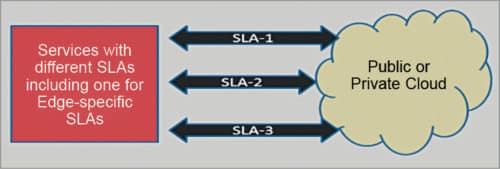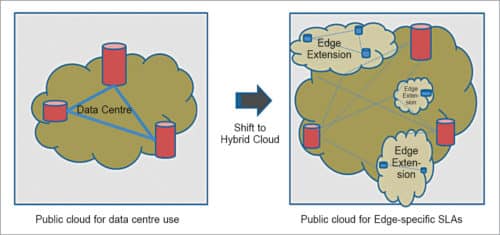As the networking business moves from OEMs to software vendors, many networking functions are now being developed on software and deployed on commodity servers. This has given a boost to virtual network functions, which provide networking nodes functionalities such as routers and firewalls through software.
Edge computing is taking up a pivotal role in telecom industries. Next-generation networks require adherent computing power close to end devices, at the front of the networks. In fact, such requirements have been attributed to real-time or low latency, which require processing of data at the point, or near the point, where it is being generated and produced.
Edge computing can be addressed through dedicated or privately-held virtualised infrastructure. It brings the cloud for Edge-specific requirements. There are vendors like VxWorks and RedHat who provide virtualised infrastructure for Edge computing needs—they also certify software for cloudification or virtualisation. There has been strong interest for cloud providers to capture the Edge, and they have been active in this space by offering hybrid cloud, which is a mix or distributed form of cloud computing with the right harmonisation and orchestration. There have also been several mergers and acquisitions in this direction, including IBM and VxWorks.
An edge for cloud providers, Edge cloud
Edge is the hierarchical distribution of certain functionalities in exchange-to-exchange (E2E) construct with the intent of being at the front or close to Edge. Edge disrupts the very nature of cloud services, as it creates a moat for innovation and business.
Hybrid cloud brings in not only private cloud but public cloud as well. And even though Edge is attributed to geographical location, it is well-understood that it is about a certain level of service-level agreements (SLAs) and key performance indicators (KPIs) required for specific application needs. Since the industry looks at hybrid cloud solutions, this approach feeds more fuel for Edge.

Edge disrupts the cloud by not only providing a back office or central office but by also distributing the work at different levels, end-to-end, in terms of SLAs and KPIs.
In that sense, Edge can be available at public cloud service providers. As for many cloud service creations for small players of specific services on cloud, cloud service providers should provide the required SLAs needed for those specific services. This will help reduce the cost of infrastructure for certain services, which are marginal for such real-time requirements as telephony-based over-the-top (OTT) services. This can also help the small players to deploy their services without cost-intensive hardware and management.
This, in turn, puts pressure on cloud service providers to create their infrastructure in a way that addresses specific SLA demands, as these demands are generated by specific service providers to perform as per the required KPIs. This could gain a fair extension in terms of cloud service providers’ business portfolios, as shown in Fig. 2.

This can also turn the business from virtualisation vendors or OEMs to cloud service providers, and re-define the term Edge as cloud SLA or Edge SLA instead of geographical earmarking.
What remains at access from the geographical location point-of-view is fog. Fog is about the virtualisation of end system resources. These end systems are mutually connected through high bandwidth links and form a cluster. Fog allows end system to share its scarce resources with others in a completely transparent way, and makes the entire cluster efficient for service demands.
Fog systems are end systems such as Wi-Fi access points or base transceiver systems in cellular networks. These are the first connection points for end users, and this is where these can provide real-time responses.
Fog systems can be better used for in-vehicle systems for autonomous or self-driving applications. These can also be beneficial for such in-building solutions as shopping malls. Fog systems may also play an important role in 5G technology applications such as beam handovers.
As the networking business moves from OEMs to software vendors, many networking functions are now being developed on software and deployed on commodity servers. This has given a boost to virtual network functions (VNFs), which provide networking nodes functionalities such as routers and firewalls through software and can be run on commodity platforms.
Since cloud provides a data centre model for back office processing, these VNFs can also be deployed to the cloud. Also, the virtualisation technology helps manage cloud infrastructure in an optimum and efficient way, for the right use of computing resources as per the need and requirement of VNFs. It can also be configured on-the-go. This helps operators deploy their networking solutions in a flexible, scalable and cost-efficient way.
This article was first published online on 28 December 2018 and was published in Electronics For You Magazine (August 2019). To read the online article: click here







